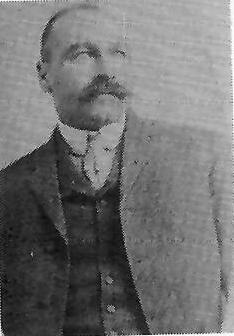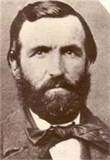ORSON PRATT BROWN
1863-1946
One of the most colorful and controversial characters of all the settlers in Mexico was Orson Pratt Brown, son of Captain James Brown, Jr. of the Mormon Battalion and founder of Ogden, Utah. It was Captain Brown’s daily diary of the Battalion that finally settled the date of the discovery of gold in California, as January 24, 1848.
Orson Pratt Brown was born in Ogden, Utah, May 22, 1863 and was named for the early Mormon Apostle, Orson Pratt. In March, 1887 when Apostle Moses Thatcher, returning from a visit to Mexico, called for volunteers to help establish and pioneer settlements there, Orson answered the call.
Orson’s father had died of an accident four months after Orson’s birth. Consequently, the deep religious faith implanted in Orson’s mind was a result of the constant companionship of his mother, Phoebe Abbott. The personal testimony of Martin Harris, Brigham Young and John Taylor concerning the Prophet Joseph Smith and the stirring events of the founding of the Church also had a profound effect on Orson’s life. In the fall of 1866 his mother married William Fife. When Orson Pratt Brown was seventeen, in October 1880, Fife moved part of two families to Arizona, and there began exciting experiences for Orson so common to early pioneer life in the West. These prepared him for an adventurous life in Mexico, after he answered the call of Apostle Thatcher in 1887, as mentioned above.
That same year he married Martha (Mattie) Dianne Romney, the first of five wives who bore him children. Their first child, Carrie, died in infancy. Mattie mothered eight children: Ray, Clyde, Dewey, Miles, Vera, Phoebe, Orson Juarez, and Anthony. Mattie died in 1943. Orson’s second wife, Jane Galbraith, bore him seven children: Ronald, Grant, Martha, Galbraith, Orson, Porfirio Diaz and Emma. Galbraith was killed in 1912 when he was eight years old, during the Exodus from Mexico. Porfirio Diaz’ name was changed to Thomas Patrick. On January 15, 1901, O. P. married a third wife, Elizabeth Graham Macdonald Webb, a widow from Mesa, Arizona, with two little girls, Elsie and Marguerite, whom Orson adopted. Elizabeth’s father was Alexander F. Macdonald, prominent in the founding of the colonies. She bore Orson two sons, Donald and Duncan. In 1902 Orson was ordained Bishop of Colonia Morelos by Apostle George Teasdale and on September 3, 1902, he married Eliza Skousen. She bore him six children: Gwendolyn, Anna, Otis Pratt, Orson Erastus, Francisco Madero and Elizabeth-his only children born in the United States.
On July 3, 1903 while Orson Pratt Brown and three other men were constructing an adobe building as a tithing warehouse, the scaffold on which they were standing while pulling up green cottonwood logs for rafters collapsed and the four men were thrown fourteen feet to the ground. Orson landed on his head and was struck by a heavy log. His neck, shoulder, and elbow were broken and his skull was cracked. Still conscious, he was carried into a house and administered to by two other men who also went down in the fall. A frontier doctor was sent for, arriving four days later. He set the shoulder and elbow, but feared to touch the neck. In his distress, as O. P. himself reports, “before they had taken their hands off my head, I felt life and strength come back into my body and I was healed. The power of the Lord was so great in the room that no one could speak for a long time.”
Orson recovered at once, rose up from his chair, tore the bandages from his head, and shouted, “I am healed!” His great faith had “wrought a miracle,” but for the rest of his life, his head veered to one side, a constant reminder of the miraculous experience.
When Orson Pratt Brown first went to Mexico he determined to learn to speak Spanish and he became exceptionally fluent. His willingness to see and understand the point of view of the Mexicans and his fairness and impartiality added to his prestige, so that in all conflicts or misunderstandings between the Mexicans and the Mormons his judgment was sought. He became the “go-between” to settle disputes, whether great or small. During the Madero Revolution when various factions raided the colonies, he carried a special letter from the revolutionary leader Francisco I. Madero certifying to the neutrality of the Mormon settlers and ordering all revolutionists to respect the homes and property of the colonists.
In 1907 he was released as Bishop of Morelos and moved his families to Colonia Dublan where he became a member of the Stake High Council, and a close friend of Anthony W. Ivins, the Stake President. During this time, he assisted in organizing the Laguna Canal Company which brought irrigation water to the Dub Ian and Casas Grandes districts and saved their crops.
When the Madero Revolution occurred in November 1910 most of the Mexican people joined with Madero against the federals. Still others joined with Generals Salazar and Alaniz who operated in the Casas Grandes area independently of Madero. Although the colonies decided to remain neutral, Orson was sent to EI Paso, Texas to request help from the Church in securing arms for their protection. In EI Paso Orson met an old friend, Abram Gonzales, rebel Governor of Chihuahua, who introduced him to Madero. Madero gave him letters to rebel officers asking them to respect the lives and property of the Mormon colonists. This gave rise to the rumor that Brown had voided the neutrality of the colonists and had sided with the Madero revolutionists. But his neutrality is evidenced by the fact that he named one of his children “Porfirio Diaz,” after the President of Mexico, and another “Francisco Madero.” He honored both sides.
Orson witnessed battles between the rebels and federals at both Agua Prieta and Ciudad Juarez, and later became inspector of cattle for the Pancho Villa forces until he had a disagreement with the rebel bandit. The three day battle at Ciudad Juarez became the turning point in the Revolution and the key that turned Mexico over to Madero. Later, Orson worked for General Bell of the U.S. Army during the time General Pershing pursued Villa into Mexico, after Villa’s raid on Columbus, New Mexico. In July, 1912, Orson was called to Thatcher, Arizona by the serious illness of his mother. While there he received a telegram from President Ivins: “Conditions serious. Return immediately.” He returned to El Paso and found a trainload of refugees from the colonies. “I have,” he said, “never witnessed such heart rending scenes, as with the anxiety of women and children who had left their husbands and fathers behind to look after the cattle and property.” Orson was on the committee to help relocate them among friends and relatives in the United States. The U.S. Government gave out relief provisions to all Americans who had been forced to flee Mexico.
Orson Pratt Brown went to Douglas, Arizona and met refugees from the colonies from Sonora, who came in wagons. When one of the wagons accidentally tipped over, his eight-year-old son, Galbraith, was killed. Before this, the continual raiding of the colonies by uncontrollable rebel bandits induced the colonists to leave Mexico. Word was received from Utah Senator Reed Smoot in Washington that the Secretary of State could not assure the refugees assistance or protection. Finally the arms Orson had been sent to EI Paso to buy arrived, and after some difficulty and delay they were released to Oscar Bluth, Ira Pratt and others. The colonists had pledged neutrality, and now with the importation of arms, a serious controversy was created, and Orson’s loyalty and integrity were questioned by both sides. It was a time of trial for Orson, for “duplicity and roguery” was charged by foe and even by old friends.
After the Exodus, he went to Douglas, Arizona to help an old friend who was having trouble with a wayward daughter, but he himself fell victim to the snare of Satan. Of this he writes: “One experience at this time made me unworthy of association with the Saints and I made a confession of my misdeeds” to the Church Authorities. Church records state briefly, “Orson Pratt Brown, High Priest, El Paso Ward, St. Joseph Stake, excommunicated, May 7, 1922 for unchastity.”
In his diary, he writes of this time in Mexico: Within the next few years of continued Revolution, General Francisco I. Madero became President of Mexico, was betrayed by his Generals, and killed. Carranza was President for a while, and he was killed. As World War I began, Obregon came into power. Still later Obregon was assassinated and General Calles became President. With such conditions existing in Mexico I could not agree with President Joseph C. Bentley that it would be wise for those who wanted to return to their homes in the colonies, to do so. Brother Bentley was right and I was wrong. I want to say this of him: He was one of the truest friends, most humble, God-fearing and courageous, of all the men I have associated with.
Later I had family troubles and my three wives all got divorces from me and I was alone. In 1919 he married Angela Gabaldon, and moved to Ciudad Juarez and was employed by the U.S. War Finance Corporation to protect their cattle interests in the Santa Clara Valley in Mexico. In 1925 he was again baptized into the Church by Bishop Arwell Pierce in EI Paso. He moved to Colonia Dublan in 1927 and presided over the Mexican Branch, and “there began to enjoy the blessings of the Gospel.” He attended the Centennial Conference of the Church in Salt Lake City in April, 1930. While there, President Anthony W. Ivins by instruction of President Heber J. Grant, “restored unto me my former blessings, the Priesthood, my wives and children.”
In his diary, under date of August 20, 1932: “I am en joying my labors among the Mexican Saints in Dublan, and I hereby give my testimony that if we are faithful in the service of the Lord, he will protect and bless us in every way that will be for our good. We are useful in this life only according to the service we render others. The privilege to serve is the greatest blessing, and it depends on the kind of service we render.”
Orson Pratt Brown died March 10, 1946 in Dublan, Mexico, age eighty-two years and ten months.
Aird Macdonald, nephew of Elizabeth Graham Macdonald Brown. Stalwarts South of the Border, Nelle Spilsbury Hatch, page 72.



